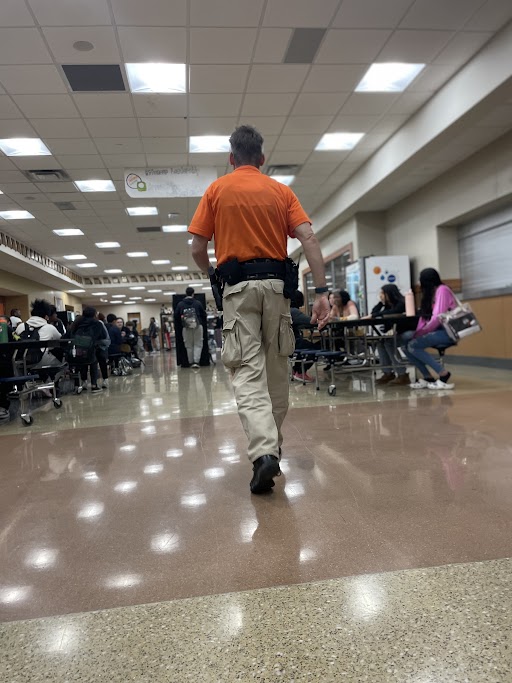Arming teachers is gaining political traction
Lea
School resource officer (SRO) Elliott Miller walks the foyer during lunch. He is one of the people at Ritenour who carries a weapon.
May 9, 2023
Recently, several state governments have been discussing the possibility of arming teachers and other faculty members with firearms in schools as another safety precaution in the event of a school intruder.
Due to increasing gun violence in the past several years, particularly in schools, there has been a demand by parents and concerned citizens for their local and federal governments to take action. As one solution to this problem, state government officials are currently discussing and passing bills in order to legalize teachers carrying concealed firearms around with them on campus and during school hours. The intention behind this is to better protect the students and teachers themselves.
Currently, there are only 16 States that actively prohibit teachers from carrying firearms, This list includes Alabama, California, Illinois, Louisiana, Maine, Maryland, Mississippi, Nebraska, New York, North Carolina, North Dakota, Rhode Island, Virginia, Washington West Virginia, and Wisconsin, as well as the District of Columbia. There are at least 29 other states that specifically allow employees other than security to carry firearms in schools, including Missouri.
Almost a decade ago, Missouri lawmakers passed a bill that allowed districts to arm their employees. This could include trained security officers or a few volunteer teachers who would receive special permission from the district, proper training, and a concealed carry permit. Recently several states have decided to implement a similar bill, but with some changes. In February of 2023, Indiana State officials approved a bill that would allow teachers and staff members to receive up to 40 hours of firearm training paid for by the state. All of the training is voluntary, but recommended.
This controversial topic raised many conflicting opinions throughout the nation. While agreeing that safety measures like security guards, metal detectors, and other safety precautions need to be taken, the majority of Americans do not think it’s a good idea for teachers to carry firearms. Even the teachers do not fully support this strategy. According to a July American Federation of Teachers survey, 75% of pre-k through 12 AFT members opposed arming teachers.
English teacher Laura Beamer is amongst the teachers who do not agree with this new potential shift in policy.
“I have the utmost respect for police officers and military personnel who have made the choice to have weapons. I did not choose a career where I would have a weapon, and that was deliberate,” Beamer said.
In addition to her own personal preference to not carry a weapon on campus, she believes that any laws that push for teachers to carry guns are representative of a government that doesn’t think it can actually solve the problem.
“I have a problem that 20 years into my teaching career people would say to me that the government is now giving up its responsibility to try to keep you safe, that they are not going to try to create an environment where you can do your job without you having to personally take responsibility for potentially killing someone to protect yourself and students. I believe that that is an abdication of responsibility and unacceptable,” Beamer said.
There are also many who are for teachers being armed in schools. According to PDK International polls, 45% of adult Americans favor arming teachers as a safety strategy.
Physical education teacher Matthew Elder stated that arming teachers could be a viable safety option as long as there is a lot of training.
“If there were extensive background checks and extensive training done, and it was limited to only specific teachers in the building to having firearms, I would be for that.”
While Ritenour does have resource officers in the building, Elder thought about schools that may not have that line of defense.
“I think that the more people who are capable in a building to stop an intruder the better,” Elder said. “There are also school districts in the United States that don’t have school resource officers, so the first line of defense is teachers. If it were to happen there would have to be a very strict and intense plan for the school district who decides to do that.”



